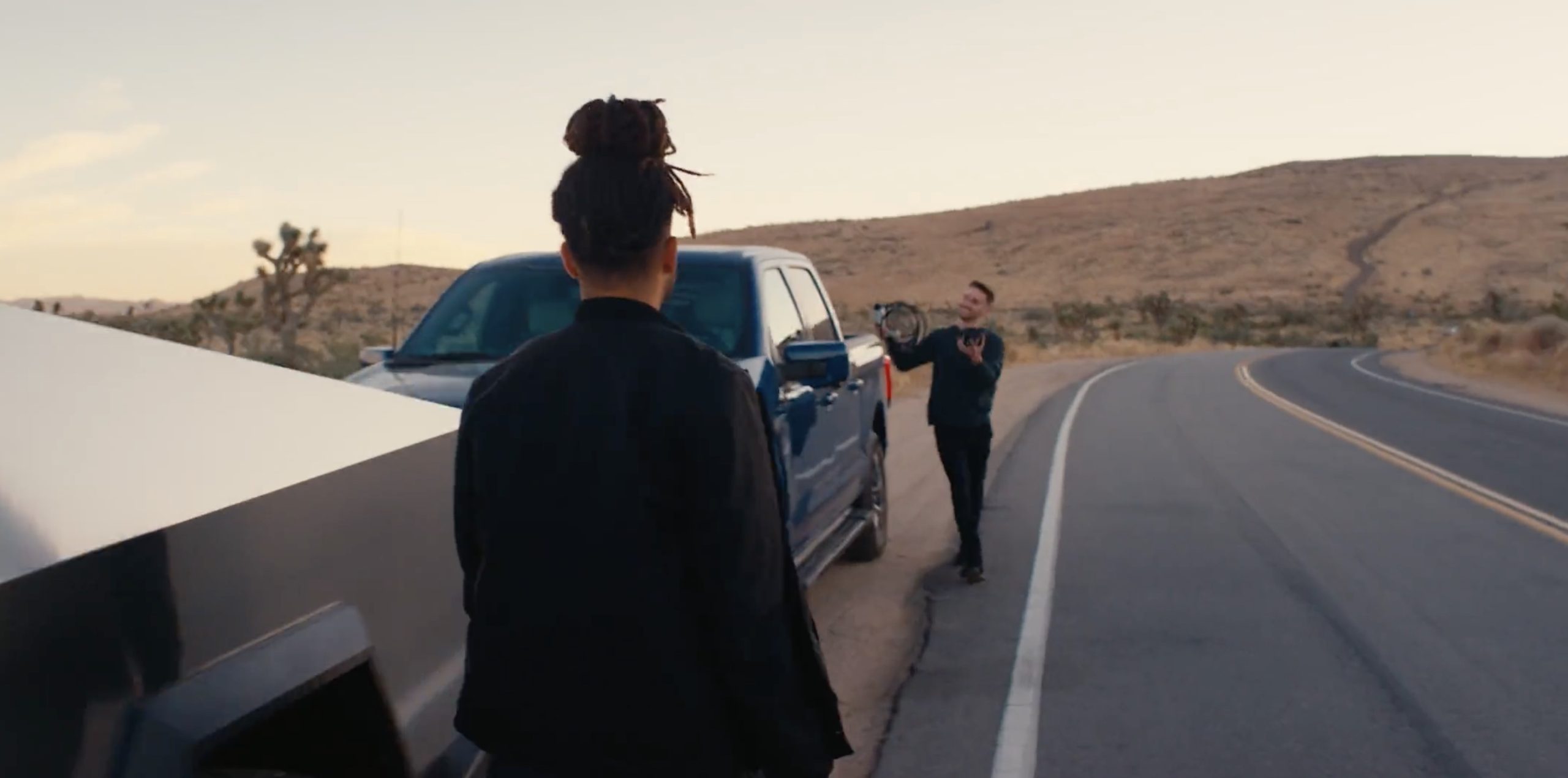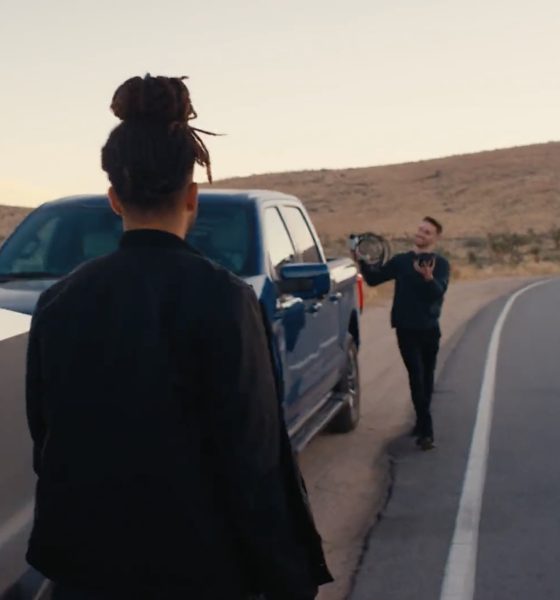

News
Tesla pokes fun at Ford F-150 Lightning in Cybertruck Powershare video
Tesla seemed to poke some fun at the Ford F-150 Lightning in its Powershare promotional video. In its highlights for the new feature, Tesla depicted a Cybertruck owner helping out an F-150 Lightning that needed some extra range on the road.
Tesla’s Powershare is a unique feature for the Cybertruck. As noted by the electric vehicle maker, the Cybertruck’s Powershare bidirectional charging system provides power for homes, activities, or other electric vehicles. “Whether you need to power a construction site, pre-game tailgate, another electric vehicle, or even your home during an outage, your Tesla vehicle with Powershare has you covered,” Tesla noted.
Interestingly enough, the Ford F-150 Lightning also has a similar feature called Pro Power Onboard, which could also provide power for homes, work sites, and other electric cars. And during the height of the Lightning’s popularity, social media platforms like X saw a notable number of posts showing F-150 Lightnings “saving” Teslas that are about to run out of battery.
just ran into a Ford F-150 Lightning owner stranded on the side of the road. Used my Cybertruck to help them get back on the road. You're welcome @mrlevine pic.twitter.com/Qswe2sZfmP— Whole Mars Catalog (@WholeMarsBlog) November 30, 2023
With the Cybertruck on the market, however, it appears that it would be Tesla that would now be saving other electric cars that are running out of range. Ironically enough, range might not be an issue for vehicles like the Lightning soon as Ford, together with other veteran automakers like General Motors (GM), have opted to adopt Tesla North American Charging Standard (NACS).
Well, my @ford F-150 Lightning saved the day once again…
I was driving home from Lowe’s with the twins when I stumbled upon an older @tesla Model S in a turn lane with its flashers on. All of their windows were down so I pulled up next to them and asked the owner if he needed… pic.twitter.com/OGXQLUagan— Ethan (@EZebroni) May 23, 2023
Not a gimmick people. Neighbor's wife forgot to charge her Tesla while visiting her parents. There was 6 miles left, added 16 miles in 25 minutes to get her back home from pro power on board at 32 amp. She said thanks @Ford @jimfarley98 @mrlevine pic.twitter.com/VQIvQHURaU— Emre (@EmreTX) June 26, 2022
With NACS, Ford’s electric vehicles would be able to access the Supercharger Network, so instances of EVs needing “saving” in the middle of the road might be quite scarce. This was hinted at by Ford CEO Jim Farley, who noted that the Tesla NACS deal is designed to improve the EV experience for consumers.
No surprise charging can be a challenge, but still learning a lot seeing firsthand the issues our customers face. This is why we’re working w/ @Tesla to provide @Ford drivers access to +12,000 superchargers & our EV certified dealers are installing fast chargers at their… pic.twitter.com/fES15o9orT— Jim Farley (@jimfarley98) August 13, 2023
“No surprise charging can be a challenge, but still learning a lot seeing firsthand the issues our customers face. This is why we’re working w/ Tesla to provide Ford drivers access to +12,000 superchargers & our EV certified dealers are installing fast chargers at their dealerships. Will help us improve the EV experience for our customers,” Farley wrote on X.
Don’t hesitate to contact us with news tips. Just send a message to simon@teslarati.com to give us a heads up.

News
Tesla starts showing how FSD will change lives in Europe
Local officials tested the system on narrow country roads and were impressed by FSD’s smooth, human-like driving, with some calling the service a game-changer for everyday life in areas that are far from urban centers.

Tesla has launched Europe’s first public shuttle service using Full Self-Driving (Supervised) in the rural Eifelkreis Bitburg-Prüm region of Germany, demonstrating how the technology can restore independence and mobility for people who struggle with limited transport options.
Local officials tested the system on narrow country roads and were impressed by FSD’s smooth, human-like driving, with some calling the service a game-changer for everyday life in areas that are far from urban centers.
Officials see real impact on rural residents
Arzfeld Mayor Johannes Kuhl and District Administrator Andreas Kruppert personally tested the Tesla shuttle service. This allowed them to see just how well FSD navigated winding lanes and rural roads confidently. Kruppert said, “Autonomous driving sounds like science fiction to many, but we simply see here that it works totally well in rural regions too.” Kuhl, for his part, also noted that FSD “feels like a very experienced driver.”
The pilot complements the area’s “Citizen Bus” program, which provides on-demand rides for elderly residents who can no longer drive themselves. Tesla Europe shared a video of a demonstration of the service, highlighting how FSD gives people their freedom back, even in places where public transport is not as prevalent.
What the Ministry for Economic Affairs and Transport says
Rhineland-Palatinate’s Minister Daniela Schmitt supported the project, praising the collaboration that made this “first of its kind in Europe” possible. As per the ministry, the rural rollout for the service shows FSD’s potential beyond major cities, and it delivers tangible benefits like grocery runs, doctor visits, and social connections for isolated residents.
“Reliable and flexible mobility is especially vital in rural areas. With the launch of a shuttle service using self-driving vehicles (FSD supervised) by Tesla in the Eifelkreis Bitburg-Prüm, an innovative pilot project is now getting underway that complements local community bus services. It is the first project of its kind in Europe.
“The result is a real gain for rural mobility: greater accessibility, more flexibility and tangible benefits for everyday life. A strong signal for innovation, cooperation and future-oriented mobility beyond urban centers,” the ministry wrote in a LinkedIn post.
News
Tesla China quietly posts Robotaxi-related job listing
Tesla China is currently seeking a Low Voltage Electrical Engineer to work on circuit board design for the company’s autonomous vehicles.

Tesla has posted a new job listing in Shanghai explicitly tied to its Robotaxi program, fueling speculation that the company is preparing to launch its dedicated autonomous ride-hailing service in China.
As noted in the listing, Tesla China is currently seeking a Low Voltage Electrical Engineer to work on circuit board design for the company’s autonomous vehicles.
Robotaxi-specific role
The listing, which was shared on social media platform X by industry watcher @tslaming, suggested that Tesla China is looking to fill the role urgently. The job listing itself specifically mentions that the person hired for the role will be working on the Low Voltage Hardware team, which would design the circuit boards that would serve as the nervous system of the Robotaxi.
Key tasks for the role, as indicated in the job listing, include collaboration with PCB layout, firmware, mechanical, program management, and validation teams, among other responsibilities. The role is based in Shanghai.
China Robotaxi launch
China represents a massive potential market for robotaxis, with its dense urban centers and supportive policies in select cities. Tesla has limited permission to roll out FSD in the country, though despite this, its vehicles have been hailed as among the best in the market when it comes to autonomous features. So far, at least, it appears that China supports Tesla’s FSD and Robotaxi rollout.
This was hinted at in November, when Tesla brought the Cybercab to the 8th China International Import Expo (CIIE) in Shanghai, marking the first time that the autonomous two-seater was brought to the Asia-Pacific region. The vehicle, despite not having a release date in China, received a significant amount of interest among the event’s attendees.
Elon Musk
Elon Musk and Tesla AI Director share insights after empty driver seat Robotaxi rides
The executives’ unoccupied tests hint at the rapid progress of Tesla’s unsupervised Robotaxi efforts.

Tesla CEO Elon Musk and AI Director Ashok Elluswamy celebrated Christmas Eve by sharing personal experiences with Robotaxi vehicles that had no safety monitor or occupant in the driver’s seat. Musk described the system’s “perfect driving” around Austin, while Elluswamy posted video from the back seat, calling it “an amazing experience.”
The executives’ unoccupied tests hint at the rapid progress of Tesla’s unsupervised Robotaxi efforts.
Elon and Ashok’s firsthand Robotaxi insights
Prior to Musk and the Tesla AI Director’s posts, sightings of unmanned Teslas navigating public roads were widely shared on social media. One such vehicle was spotted in Austin, Texas, which Elon Musk acknowleged by stating that “Testing is underway with no occupants in the car.”
Based on his Christmas Eve post, Musk seemed to have tested an unmanned Tesla himself. “A Tesla with no safety monitor in the car and me sitting in the passenger seat took me all around Austin on Sunday with perfect driving,” Musk wrote in his post.
Elluswamy responded with a 2-minute video showing himself in the rear of an unmanned Tesla. The video featured the vehicle’s empty front seats, as well as its smooth handling through real-world traffic. He captioned his video with the words, “It’s an amazing experience!”
Towards Unsupervised operations
During an xAI Hackathon earlier this month, Elon Musk mentioned that Tesla owed be removing Safety Monitors from its Robotaxis in Austin in just three weeks. “Unsupervised is pretty much solved at this point. So there will be Tesla Robotaxis operating in Austin with no one in them. Not even anyone in the passenger seat in about three weeks,” he said. Musk echoed similar estimates at the 2025 Annual Shareholder Meeting and the Q3 2025 earnings call.
Considering the insights that were posted Musk and Elluswamy, it does appear that Tesla is working hard towards operating its Robotaxis with no safety monitors. This is quite impressive considering that the service was launched just earlier this year.








